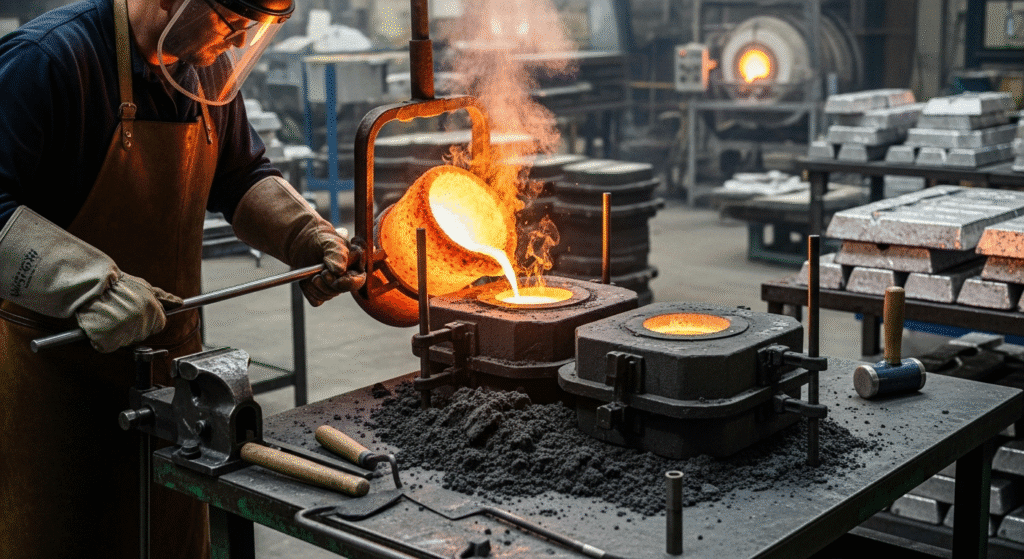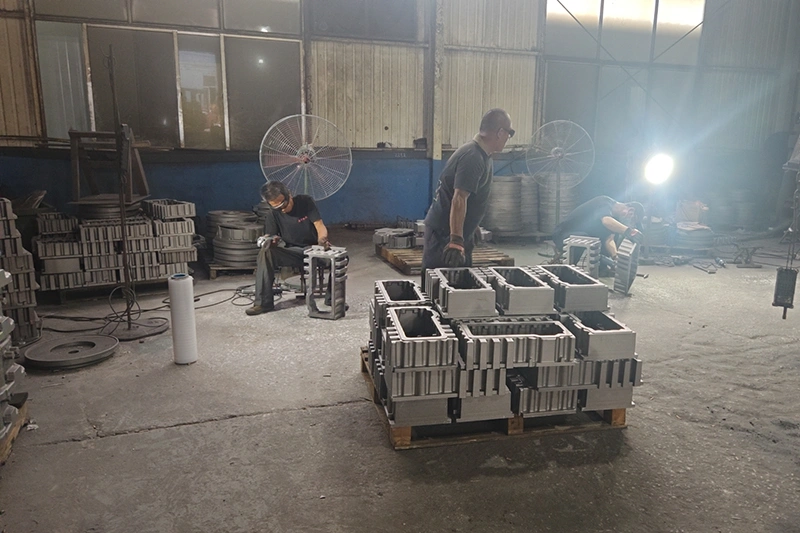Sand casting is a metal manufacturing process where you pour molten metal into a mold made from sand. Think of it like making sandcastles at the beach, except instead of water holding the sand together, you use special binding agents, and instead of filling it with air, you fill it with liquid metal that hardens into your desired shape.
This manufacturing method has been around for over 6,000 years. Today, it produces everything from engine blocks to decorative sculptures.
The beauty of sand casting lies in its simplicity. You pack sand around a pattern, remove the pattern to leave a cavity, then fill that cavity with molten metal.

First, you create a pattern – an exact replica of the part you want to make. This pattern is typically made from wood, plastic, or metal and is slightly larger than the final part to account for metal shrinkage during cooling.
Think of the pattern as a master copy. Just like using a cookie cutter shapes dough, this pattern will shape the sand.
Pack special molding sand around the pattern inside a metal frame called a flask. The flask usually comes in two halves – the top half (cope) and the bottom half (drag).
The sand mixture contains clay and water, which makes it stick together like wet beach sand. When you compress it around the pattern, it holds its shape perfectly.
Carefully separate the flask halves and remove the pattern. You now have a perfect negative impression of your part in the sand.
This cavity is where the magic happens. It’s the exact shape of the part you want to create.
Cut channels called gates and runners into the sand mold. These channels guide the molten metal from the pouring point to the cavity.
You also add risers – vertical channels that act as reservoirs. They feed extra metal to the casting as it shrinks during cooling, preventing defects.
Put the cope and drag back together and clamp them tightly. Any misalignment here will create a defective part.
Small pins or guides ensure the two halves line up perfectly. The weight of the sand and clamps prevent the mold from separating when you pour the metal.
Heat the metal until it’s completely liquid, then pour it into the mold through the gating system. The temperature depends on the metal – aluminum melts at about 1,220°F, while steel needs temperatures over 2,500°F.
Pour steadily and continuously. Stopping and starting can create cold spots and weak points in the final casting.
Let the metal cool and harden inside the mold. Cooling time varies from minutes for small aluminum parts to hours for large iron castings.
The risers you added earlier continue feeding liquid metal to the main casting as it shrinks. This prevents hollow spots or voids from forming.
Once cooled, break apart the sand mold to reveal your metal part. The sand can often be recycled for the next casting.
Your part will have extra metal attached from the gates and risers. These need to be cut off in the next step.
Remove the excess metal from gates and risers using saws or grinders. Sand or shot blast the surface to remove any remaining sand particles.
Depending on requirements, you might also heat-treat the part for strength or machine it for precise dimensions.
Green sand is the most common molding material, making up about 60% of all sand casting. Despite its name, it’s not green in color – “green” means it contains moisture.
This mixture combines silica sand (85-95%), bentonite clay (4-10%), and water (2-5%). The clay acts like glue, binding the sand grains together when moistened.
Green sand is cheap and reusable. You can break it apart after casting, add some water, and use it again immediately.
Olivine sand comes from a greenish mineral that handles extreme heat better than regular silica sand. It’s perfect for casting steel and other high-temperature metals.
This sand produces smoother surface finishes because it doesn’t expand as much when heated. Less expansion means fewer cracks and defects in your casting.
The downside? Olivine costs more than regular sand and isn’t as widely available.
Chromite sand is the heavyweight champion of molding sands. Its high thermal conductivity pulls heat away from the molten metal faster, creating finer grain structures in the casting.
This rapid cooling effect is especially valuable for heavy steel castings. The faster cooling prevents defects and improves the metal’s mechanical properties.
Chromite sand also resists metal penetration better than silica sand. This means cleaner surfaces that need less finishing work.
Zircon sand has the lowest thermal expansion of all molding sands. When other sands expand and crack under extreme heat, zircon stays stable.
This stability makes it ideal for precision castings where dimensional accuracy is critical. It’s commonly used for aerospace components and turbine blades.
Zircon also creates exceptionally smooth surface finishes. However, it’s the most expensive option, sometimes costing 10 times more than silica sand.
Chamotte sand is recycled fireclay that’s been crushed into granules. It’s essentially pre-fired ceramic material that can withstand extreme temperatures without breaking down.
This sand works well for large steel castings where you need a stable mold that won’t shift or deform. It’s particularly useful for castings that take hours to cool.
While not as common as other sands, chamotte offers excellent reusability. It can withstand multiple casting cycles without degrading.
Sand castings typically have a surface roughness of 250-500 microinches. The finish depends on sand grain size – finer sand creates smoother surfaces, while coarse sand leaves a rougher texture.
Sand casting walls should be at least 3mm (1/8 inch) thick for small castings and 6mm (1/4 inch) for larger ones. Thinner walls risk incomplete filling or cracking during cooling.
Green sand contains moisture and clay as binders, while dry sand molds are baked in an oven to remove moisture. Dry sand creates more accurate dimensions but takes longer and costs more.
Yes, sand cores placed inside the mold create hollow sections. After casting, you break out these cores to leave internal cavities, perfect for parts like engine blocks with cooling channels.
Sand casting typically achieves tolerances of ±0.5mm to ±3mm depending on size. It’s less precise than die casting or investment casting but accurate enough for many applications.

